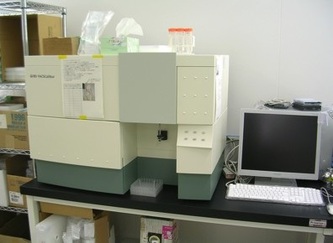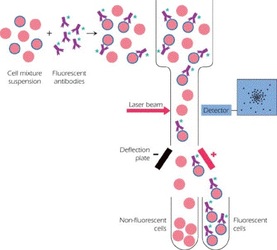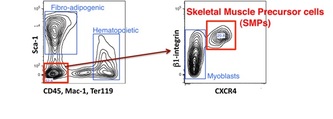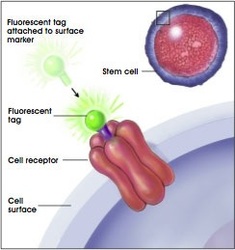Week 6: The Facts about FACSby Stephanie Wang Most stem cell laboratories work with a specialized technique called fluorescence-activated cell sorting or FACS. A huge hulk of a machine, FACS sorters are able to sort cells individually, examining thousands upon thousands of cells one at a time in a period of minutes. By the end of this blogpost, I hope you will be able to understand this complicated technique and its significance. In the Wagers Lab, I have utilized FACS to separate muscle stem cells (also known as the skeletal muscle precursor cell population) from other cells derived from the whole skeletal muscle extracted from mice. First taking muscles that range from the rubber-like abdominal muscle to the compact triceps and quads, I then utilize enzymes to digest the muscle in order to separate the myofibers from the whole muscle and then the individual muscle cells from each other. In the end of the digestion and filtration process, I am left with tubes of satellite cells, cells that lay upon the outer layer of the muscle (where the muscle stem cells are located). I then expose these cells to fluorescent antibodies. In the diagram below, the antibodies are illustrated as forked purple objects, attached to a fluorescent probe. After staining the cells with these antibodies which are specific to muscle stem cell antigens such as Sca-1 (aptly named stem cell antigen-1), the cells are placed into a FACS sorter. Using high pressure and an extraordinarily narrow nozzle, the machine is able to probe individual cells at a time with a laser, determining whether they are labeled or not. Using an electric field, labeled cells are given a negative charge while unlabeled ones are given a positive charge, allowing the cells to be separated. Thus, they are “sorted by fluorescence-activation.” Seems pretty simple, right? Yet, the process is so complicated that three full-time technicians are needed to take care of the two FACS machines in the Bauer Laboratory FACS Core. They clean, maintain, and run the machines which cost about 10,000 dollars each (not including their daily maintenance fees!). Moreover, the gating of cells, based upon the various stem-cell-specific antibodies can also be complex, as exhibited by the small charts below. The skeletal muscle precursor cell population, the cell population I am interested in, is only 20.8% of the cells after whole muscle digestion and filtering, which is pretty typical. Often, only up to 10,000 muscle stem cells can be purified per mouse. It is incredible that we can now isolate these rare cells with incredible potential. Where once working with stem cells meant working with embryonic stem cells, today, we can isolate stem cells from liver, muscle, and blood using FACS. Every month, new, exciting techniques and machines are being developed to streamline old methods—FACS is just one technique out of many that has given biologists the tools to examine cells in a novel manner. It truly amazes me at what technology can do nowadays! I am excited to see what the future holds, for research and for science. About the Blogger
0 Comments
Your comment will be posted after it is approved.
Leave a Reply. |
The Lab JournalWelcome to the summer internship series of 2012! Follow 9 Scientista bloggers through their summer internships to catch a glimpse of what it is like to be a scientista^TM. By Title- India Presents: A "New World Symphony"
- Through The Lens: The Intricacies Of Diabetes - Do Nanoparticles Glow? - Using Unusual Animals to Study Human Disease - Using the Hubble Telescope - You Think What You Eat - Experimenting With the Life of a Scientist(a) - 18.085: My Summer at MIT - Science Heals: A Summer of Global Health Research By BloggerRabeea Ahmed
Riana Balahadia Shaira Bhanji Nzuekoh Nchinda Amy Beth Prager Natalie Punt Juliet Snyder Pin-Wen Wang Stephanie Wang Archives |
The Scientista Foundation, Inc. All Rights Reserved © 2011-2021 | Based in NY | [email protected]
The Network for Pre-Professional Women in Science and Engineering
The Scientista Foundation is a registered 501(c)(3) -- Donate!
The Network for Pre-Professional Women in Science and Engineering
The Scientista Foundation is a registered 501(c)(3) -- Donate!






 RSS Feed
RSS Feed